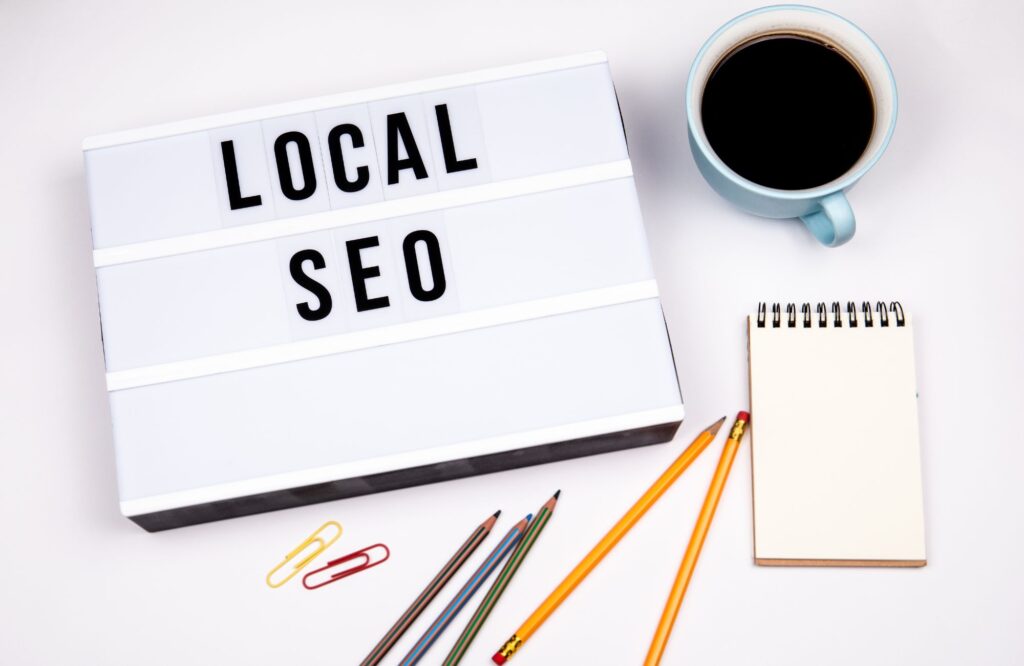Local SEO is one of the most powerful ways small businesses can compete with larger brands. At its core, local search engine optimization or local seo focuses on making your business visible to people searching in a specific city, neighborhood, or service area. Whether someone is looking for a dentist in Stamford, a med spa in Danbury, or ABA therapy in New Haven, local SEO helps ensure your business appears in local search results like Google Maps and the local pack. This article serves as the definitive guide to local SEO, providing everything you need to know to boost your local search visibility.
For small businesses across Connecticut and nationwide, this can be the difference between blending in or standing out. Strong local SEO strategies not only increase calls, foot traffic, and form submissions, but they also give businesses a trusted presence online. In this guide, we’ll cover what local SEO is, why it matters, how it works, and step-by-step strategies you can implement to improve your rankings.
What Is Local SEO?
Local SEO is the process of improving your online visibility in location-based searches across Google Search, Google Maps, and other search engines. It ensures that when nearby customers search for a service, your business shows up prominently in the local pack or on the search results page.
This differs from traditional SEO because Google uses additional ranking signals, like your Google Business Profile, reviews, and proximity, to decide which businesses deserve top placement. For example, if a user searches “dentist near me” in Stamford, Google will prioritize results based on which businesses are closest, most relevant, and have the best reputation.
Understanding and optimizing for local search intent helps businesses connect with customers who are actively seeking their services, increasing the chances of attracting local clients and improving visibility in local search results. It’s not about competing with every business in the country; it’s about winning in your local area.
Why Is Local SEO Important?
Local SEO is important because it improves your business’s visibility and helps you achieve high rankings in local search results, connecting your business with customers who are ready to buy in your area. According to Think with Google, 76% of people who conduct a local search on their smartphone visit a business within a day. If your business isn’t optimized for local visibility, you’re leaving potential leads to competitors.
For service-based businesses, the stakes are even higher. For instance, a plumber in Stamford who ranks at the top of Google’s map pack is far more likely to get emergency calls than one buried in the results. Dentists in Danbury, med spas in New Haven, and ABA therapy centers in Bridgeport all depend on local search visibility to keep new clients flowing in. This is why local SEO is one of the highest-ROI marketing strategies for small businesses; it helps you capture demand that already exists in your community.
How Does Local SEO Work?
Google ranks local search results based on three key signals: relevance, distance, and prominence, along with Google’s additional ranking signals. These factors help the search engine match customers with the businesses most likely to meet their needs.
| Factor | What It Means | How to Improve |
|---|---|---|
| Relevance | How well does your business match the query | Optimize your Google Business Profile, add services |
| Distance | Proximity of business to the searcher’s location | Create service area pages, optimize for nearby cities |
| Prominence | How well-known and reputable your business is | Collect reviews, earn backlinks, build citations |
For businesses in competitive markets, relevance and prominence are crucial. Even if you’re slightly farther from the searcher, strong optimization can help you appear in the map pack.
Local Search Results and Local Packs
Local search results and local packs are central to local search engine optimization for local businesses. When customers use search engines like Google to find services or products nearby, the search results page often displays a special section known as the local pack. This section highlights the top three businesses most relevant to the query, complete with their business profile details, reviews, and a map location.
To improve your chances of appearing in these coveted local packs, focus on:
- Optimizing your Google Business Profile – Include accurate information such as your business name, address, phone number, website, and hours.
- Maintaining consistent NAP (Name, Address, Phone) across all online listings to help search engines verify your business.
- Encouraging positive online reviews – Feedback from customers not only builds trust but also signals credibility to Google.
- Keeping details up to date – Ensure that business hours, services, and contact details are always current.
- Using relevant local keywords – Incorporate location-based terms into your profile and website pages to align with local search intent.
By focusing on these elements, businesses can increase their visibility in local search results, attract more nearby customers, and drive valuable foot traffic.
How to Do Local SEO (Step-by-Step)
Local SEO requires a targeted approach that combines your online presence with community signals. Below are the most important steps, each designed to improve your visibility and attract more customers.
1. Optimize Your Google Business Profile
Your Google Business Profile (formerly Google My Business) is the foundation of local SEO. A verified and well-optimized profile makes your business eligible for the local pack and Google Maps.
Key actions:
- Verify ownership of your profile.
- Choose the right categories (e.g., dentist, chiropractor, ABA therapy provider).
- Add services, hours, and a detailed business description.
- Update your business details regularly, including opening hours, address, and contact information.
- Upload high-quality photos and videos.
- Post regular updates about promotions, events, or hiring needs.
Geo Example: An ABA therapy clinic in Danbury can add “in-home ABA therapy” under services, helping them show up for parents searching for in-home providers.
2. Get More Reviews
Online reviews are one of the strongest signals of prominence because they influence search rankings and build trust with potential customers. The best practices include asking satisfied customers for reviews through email or SMS, displaying QR codes in offices or storefronts, and responding to every review, positive or negative, to demonstrate engagement.
For example, dentists can encourage patients to leave reviews after appointments, while med spas may send follow-up texts with direct review links.
3. Build and Fix Citations
Citations, mentions of your business name, address, and phone number across directories, help Google verify your legitimacy. Building consistent NAP citations across all platforms is essential for local SEO success, as it ensures your business information is accurate and trusted by search engines.
To improve citations:
- Ensure NAP consistency across all directories.
- Submit to major platforms (Yelp, Bing Places, Facebook).
- Use Connecticut-specific directories like CT.gov or local chambers of commerce.
- Audit existing listings for errors.
Even though citations aren’t as powerful as they once were, they’re still foundational for building local trust.
4. Local Keyword Research
Finding valuable local keywords ensures your site targets what nearby customers are searching for.
Steps:
- Use Google Autocomplete to find long-tail queries (“emergency plumbing New Haven”).
- Analyze a competitor’s domain with SEO tools like Google Keyword Planner or Semrush to uncover relevant keywords and local SEO opportunities.
- Use keyword research tools to find local keywords that reflect the search terms used by nearby customers.
- Add local modifiers like “near me,” city names, or neighborhoods.
Targeting relevant keywords can help your site appear in local organic results, not just the map pack. For example, instead of just targeting “plumber,” create content for “24-hour plumber in Stamford.”
For niche industries like ABA therapy, targeting the right keywords is even more important. Parents often search with intent phrases such as ‘in-home ABA therapy near me’ or ‘autism therapy in Danbury.’ Learn more about how we help clinics rank higher with our ABA Therapy SEO strategies.
5. On-Page SEO for Local Relevance
On-page signals remain essential for ranking in both the local pack and organic search.
Checklist:
- Add location pages for each service area (e.g., “ABA Therapy in Danbury, CT”).
- Optimize title tags and meta descriptions with local keywords.
- Include NAP details on your contact page and footer.
- Use structured data (LocalBusiness schema) to improve how your site appears in search engine results and for better visibility.
6. Build Local Backlinks
Backlinks from other local businesses and organizations improve prominence. Unlike general link building, local backlinks show Google that your business is active in its community.
Ideas:
- Sponsor community events.
- Partner with local nonprofits or resource groups.
- Pitch stories to local newspapers and blogs.
- Collaborate with complementary businesses (e.g., dentists partnering with orthodontists).
- Collaborate with other local websites to build backlinks and strengthen your local SEO.
Local SEO Tools to Streamline Your Efforts
Using the right local SEO tools can make a world of difference for businesses aiming to boost their local search visibility. These tools are designed to simplify and automate many aspects of local search engine optimization, from optimizing your Google Business Profile to tracking your search rankings and managing online reviews.
Popular local SEO tools like Google Search Console and Google My Business (now Google Business Profile) provide direct insights into how your business appears in Google search and maps. Platforms such as Semrush, Ahrefs, and Moz Local help you monitor your local citations, analyze competitors, and identify new opportunities to improve your local SEO strategy. These tools also make it easier to spot inconsistencies in your business profile, track changes in search rankings, and manage your online reputation.
How to Measure Local SEO Success
It’s not enough to launch a strategy, you also need to measure its impact. Tracking results shows whether your efforts are improving visibility and driving customers. Without measurement, it’s impossible to refine and strengthen your local SEO over time.
Metrics to measure:
- Google Business Profile insights: calls, website clicks, and direction requests.
- Grid rankings: visibility across multiple locations in your city.
- Reviews: quantity, rating, and growth rate.
- Citations: percentage of corrected listings.
- Organic traffic: keyword growth and location-based conversions.
Tracking your progress toward higher rankings in local search results is essential for measuring success.
| KPI | Target Goal |
|---|---|
| Avg. Star Rating | 4.5+ |
| Reviews Per Month | 3–5 |
| Grid Coverage | 60%+ |
| Citation Accuracy | 100% |
For ABA providers, local SEO isn’t just about client leads; it also plays a role in hiring. A polished profile and strong online reputation can attract job applicants searching for opportunities. That’s why we combine marketing with ABA Recruitment services to help fill critical roles.
Common Local SEO Mistakes to Avoid
Even the best local SEO strategy can be undermined by common mistakes. Knowing what they are helps you avoid setbacks and keep your business visible in search results.
Inconsistent NAP Citations
One of the biggest pitfalls in local SEO is inconsistent NAP (name, address, and phone number) citations across different business directories and platforms. When search engines find conflicting information, it can hurt your chances of appearing in local search results and local packs.
Neglecting Your Google Business Profile
Another frequent mistake is neglecting your Google Business Profile. Failing to keep it updated with accurate details, business hours, and photos can result in missed opportunities to connect with nearby customers.
Keyword Stuffing
Keyword stuffing, overusing keywords in your business description or website, makes your content less appealing to both search engines and potential customers. Instead, focus on using relevant keywords naturally.
Low-Quality Backlinks and Duplicate Content
Low-quality backlinks and duplicate content can negatively impact your search rankings. Search engines prioritize credible sources and unique content when determining which sites to rank higher.
Ignoring Online Reviews
Ignoring online reviews or failing to respond to customer feedback can damage your reputation and deter new customers. To build trust and improve local search results, always respond promptly to both positive and negative reviews.
Local SEO Challenges and How to Overcome Them
Local SEO can be highly effective, but it’s not without hurdles. From competition with larger brands to managing customer reviews, businesses must address these challenges head-on to maintain strong local search visibility.
Competing in Crowded Local Search Results
Local SEO presents unique challenges, especially for small businesses competing against larger brands with more resources. One major hurdle is standing out in crowded local search results. To overcome this, focus on building high-quality local citations and ensuring your Google Business Profile is complete and accurate. Creating content tailored to your target audience and highlighting what makes your business unique can also help you connect with local customers.
Managing Online Reviews
Managing online reviews is another common challenge. Negative reviews can impact your search visibility and deter potential customers. The best approach is to implement a proactive review management strategy: encourage satisfied customers to leave feedback, respond quickly to all reviews, and use constructive criticism to improve your services.
Adapting to Search Algorithm Changes
Staying on top of changes in the search landscape is also essential. Regularly review your local SEO strategy, monitor your search visibility, and adapt as needed. By focusing on these areas, small businesses can overcome local SEO challenges and achieve stronger local search visibility, even in competitive markets.
Conclusion
Local SEO is one of the most powerful tools small businesses can use to connect with nearby customers and build long-term visibility. By focusing on relevance, distance, and prominence, companies can improve their chances of showing up in Google’s local pack and on maps. Whether you’re a dentist, a med spa, or an ABA therapy provider, optimizing for local search helps you reach the right people at the right time and convert searches into loyal customers.
At ChitChat Marketing, we specialize in building SEO strategies that balance all three pillars, on-page, off-page, and technical, so your business can stand out in competitive search results. Ready to take the next step toward stronger rankings and more organic traffic? Contact us today for a free SEO strategy session.
FAQs
What does local SEO mean?
Local SEO means optimizing your business’s online presence so it shows up in local search results on Google, Google Maps, and other search engines. It focuses on helping nearby customers find your business when they’re searching for services in their area.
What’s the difference between SEO and local SEO?
SEO improves visibility in search results on a national or global scale, while local SEO focuses on location-based searches. Local SEO aims to improve your visibility in local results, such as the map pack and local organic listings. Local SEO considers signals like proximity, Google Business Profiles, and reviews, making it especially important for small businesses that serve specific areas.
Is doing local SEO worth it?
Yes, local SEO is worth it because it connects you directly with potential customers in your area. Statistics show that nearly 80% of local searches lead to offline purchases, making it one of the most effective strategies for attracting foot traffic, calls, and new leads.
What are the 4 types of SEO?
The four main types of SEO are:
- On-page SEO – optimizing website content and keywords.
- Off-page SEO – building backlinks and external authority.
- Technical SEO – improving site speed, indexing, and structure.
- Local SEO – targeting location-based searches with Google Business Profiles, reviews, and citations.




